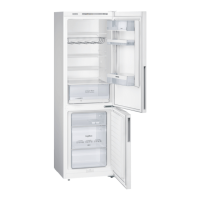en Defrosting
48
Thawing frozen food
The thawing method must be adjusted
to the food and application in order to
retain the best possible product quality.
Thawing methods:
■ in the refrigerator compartment
(especially suitable for animal-based
foods such as fish, meat, cheese,
quark)
■ at room temperature (bread)
■ in the microwave (food for
immediate consumption or
immediate preparation)
■ in the oven/cooker (food for
immediate consumption or
immediate preparation)
Caution!
Do not refreeze thawing or thawed food.
You can only refreeze the food when it
has been used for a ready-to-eat meal
(boiled or fried).
The frozen food can no longer be stored
for the maximum duration.
= Defrosting
Defrosting
The fully automatic NoFrost system
ensures that the appliance remains free
of ice. Defrosting is not required.
D Cleaning
Cleaning
Caution!
Avoid damaging the appliance and the
fittings.
■ Do not use abrasive, chloride or
acidic cleaning agents or solvents.
■ Do not use scouring or abrasive
sponges.
The metallic surfaces may corrode.
■ Never clean the shelves
or containers in the dishwasher.
The parts may become deformed.
Proceed as follows:
1. Switch off the appliance.
2. Pull out the mains plug or switch off
the fuse.
3. Take out the food and store
in a cool location.
Place ice pack (if available)
on the food.
4. If present: wait until the layer of frost
has thawed.
5. Clean the appliance with a soft cloth,
lukewarm water and a little
pH-neutral washing-up liquid.
Caution!
The rinsing water must not get into
the lighting system or into the
ventilation openings.
6. Wipe door seal with clear water and
dry thoroughly with a cloth.
7. Reconnect and switch on appliance
and put in food.

